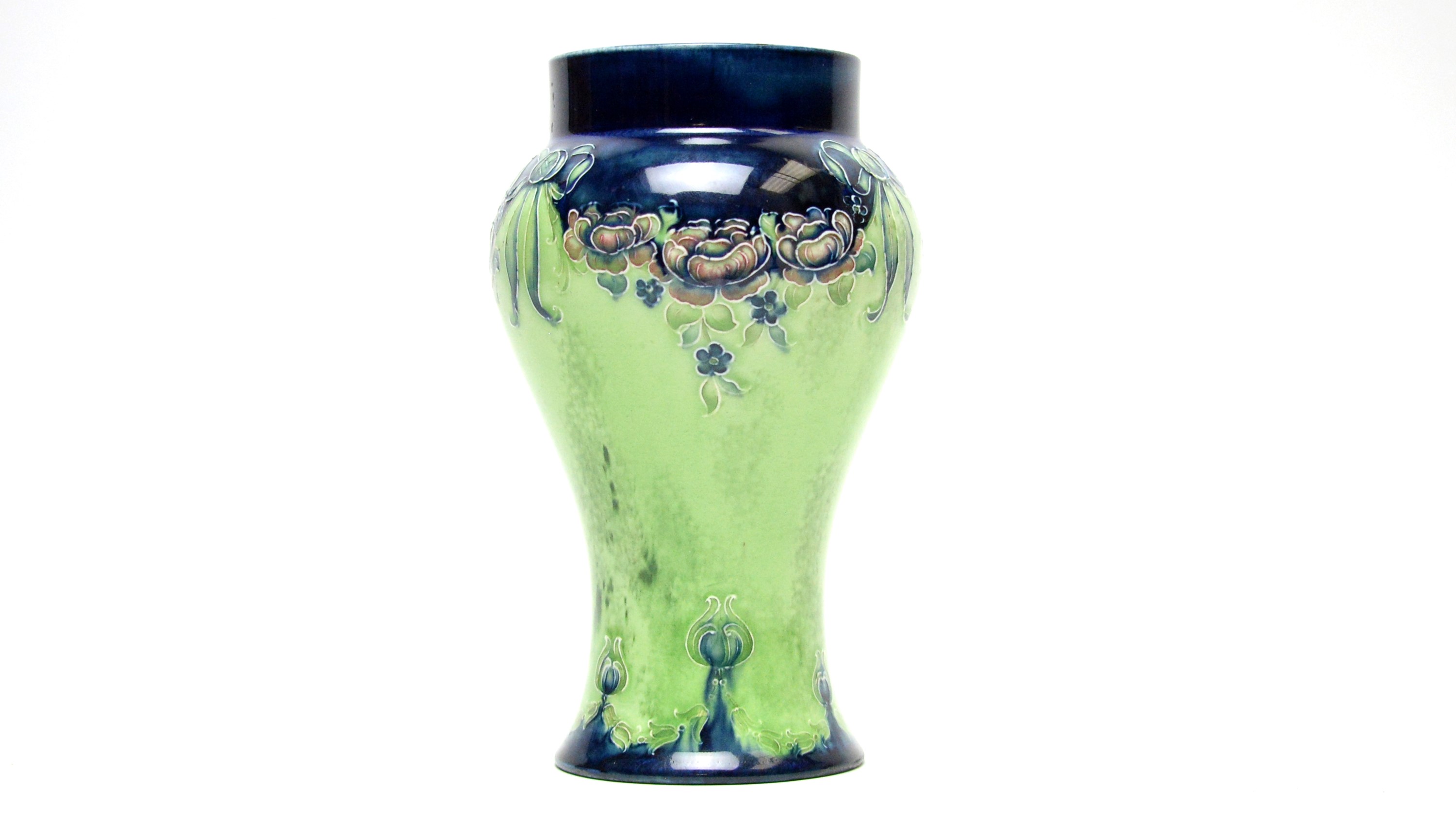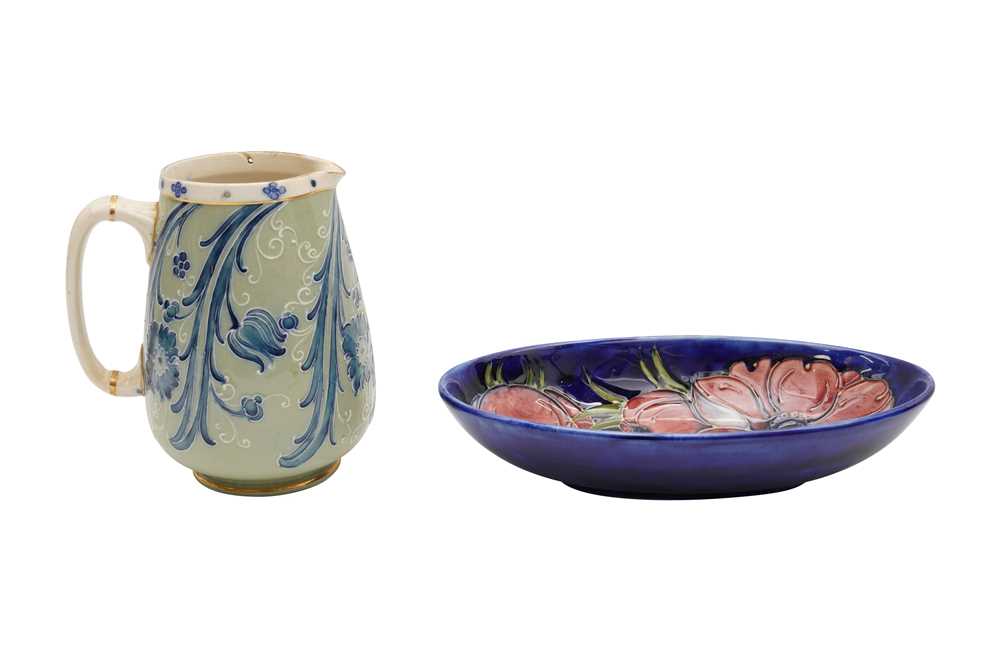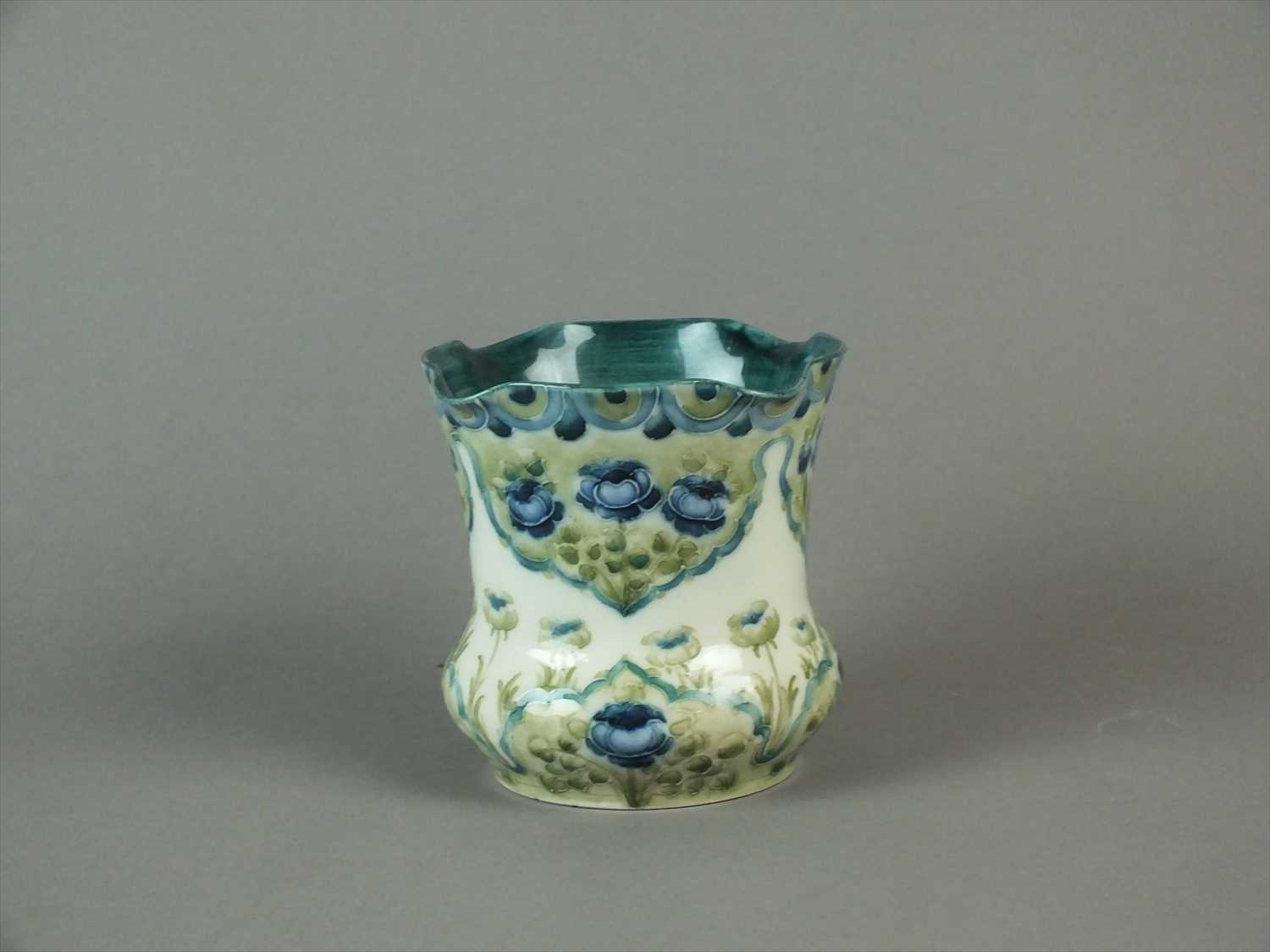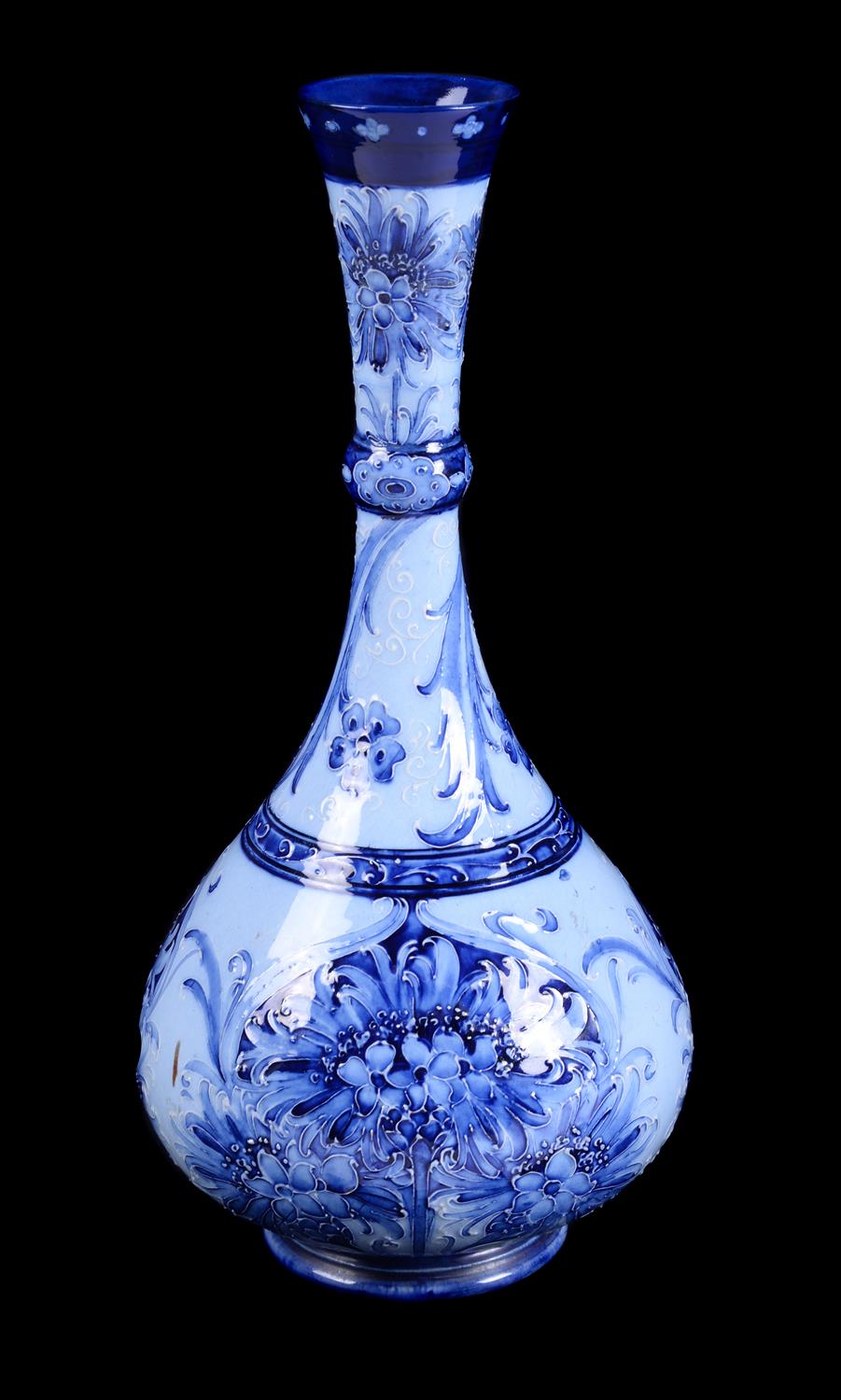glazed earthenware, painted signature in green, printed factory stamp, impressed 143 22.5cm high Note: In 1897 William Moorcroft was employed as a designer at James Macintyre & Co.; with a background in ceramic chemistry, he was a keen experimenter and introduced an array of new wares and glazes to the production line. However, it wasn’t until the launch of ‘Florian Ware’, one year later, which really cemented his reputation as a talented designer and ceramicist. The arrangement of sinuous flowing lines and intricate foliate patterns were outlined using an applied raised slip, a technique known as tube-lining. Moorcroft was meticulous, and oversaw every stage of production to ensure quality was met at the highest level; and Florian Ware was the first range in which Moorcroft began to sign his name or initials on every piece he worked on and supervised. Over the next few years, richer colours were introduced and several new patterns were registered. In particular, the charming designs of trees amongst rolling hills in an English countryside caught the eye of Liberty’s in London, and a partnership was soon struck between Moorcroft and the company. who remained a major outlet of his pottery, as well as other significant retailer’s such as Harrod’s and Tiffany & Co. In 1912 Moorcroft’s relationship with the directors at James Macintyre disintegrated and in 1913, with the financial backing of the Liberty family, he opened his own pottery in Cobridge. He was inundated with orders from several distributors who were keen to support his venture, and many of the popular patterns from the Macintyre period such as Spanish, Pomegranate, Hazeldene and Claremont, continued to be produced at Cobridge. However, he was also keen to develop his particular interest in his Florian-style designs and some of these early Macintyre patterns were revived and redeveloped in bolder forms and richer colours from the late 1920s. By the 1930s, tastes were beginning to change and whilst English native flowers always remained central to his most popular wares, Moorcroft started to look further afield for new inspiration. Amongst some his hi contemporaries, for example Charles Noke and Bernard Moore there was a growing interest in the high-fired Oriental wares which produced the most intense and dramatic effects. To achieve these flambé glazes Moorcroft built his own special kiln and was highly secretive about his methods, however the ware produced as a result were arguably some of his most remarkable, given the complex and demanding nature of the skills required. Whilst other potteries sought to deliver a consistent sang de boeuf colour, Moorcroft embraced the unpredictable nature of the kiln and the eccentric array of colourful glazes it could produce, making every piece unique. Walter Moorcroft took over management of the pottery after his father’s passing in 1945. During a few difficult years of transition, his father’s designs were crucial in ensuring the success and continuation of the business, but soon after Walter developed his own style which matured into the 1950s. William displayed a clear preference in using English flowers and landscapes for his wares, however Walter was fascinated by more exotic species and so patterns such as Hibiscus, Arum Lily, Caribbean and Marine began to emerge alongside a dramatic use of colour. Importantly, Walter was also knowledgeable of the transmutation process and exhibited the same skill as his father to continue the production of flambé wares. In 1998 the pottery established a new Design Studio, led by Senior Designer Rachel Bishop, to further expand its range of products and continues to build on William and Walter’s legacy today.
glazed earthenware, painted signature in green, printed factory stamp, impressed 143 22.5cm high Note: In 1897 William Moorcroft was employed as a designer at James Macintyre & Co.; with a background in ceramic chemistry, he was a keen experimenter and introduced an array of new wares and glazes to the production line. However, it wasn’t until the launch of ‘Florian Ware’, one year later, which really cemented his reputation as a talented designer and ceramicist. The arrangement of sinuous flowing lines and intricate foliate patterns were outlined using an applied raised slip, a technique known as tube-lining. Moorcroft was meticulous, and oversaw every stage of production to ensure quality was met at the highest level; and Florian Ware was the first range in which Moorcroft began to sign his name or initials on every piece he worked on and supervised. Over the next few years, richer colours were introduced and several new patterns were registered. In particular, the charming designs of trees amongst rolling hills in an English countryside caught the eye of Liberty’s in London, and a partnership was soon struck between Moorcroft and the company. who remained a major outlet of his pottery, as well as other significant retailer’s such as Harrod’s and Tiffany & Co. In 1912 Moorcroft’s relationship with the directors at James Macintyre disintegrated and in 1913, with the financial backing of the Liberty family, he opened his own pottery in Cobridge. He was inundated with orders from several distributors who were keen to support his venture, and many of the popular patterns from the Macintyre period such as Spanish, Pomegranate, Hazeldene and Claremont, continued to be produced at Cobridge. However, he was also keen to develop his particular interest in his Florian-style designs and some of these early Macintyre patterns were revived and redeveloped in bolder forms and richer colours from the late 1920s. By the 1930s, tastes were beginning to change and whilst English native flowers always remained central to his most popular wares, Moorcroft started to look further afield for new inspiration. Amongst some his hi contemporaries, for example Charles Noke and Bernard Moore there was a growing interest in the high-fired Oriental wares which produced the most intense and dramatic effects. To achieve these flambé glazes Moorcroft built his own special kiln and was highly secretive about his methods, however the ware produced as a result were arguably some of his most remarkable, given the complex and demanding nature of the skills required. Whilst other potteries sought to deliver a consistent sang de boeuf colour, Moorcroft embraced the unpredictable nature of the kiln and the eccentric array of colourful glazes it could produce, making every piece unique. Walter Moorcroft took over management of the pottery after his father’s passing in 1945. During a few difficult years of transition, his father’s designs were crucial in ensuring the success and continuation of the business, but soon after Walter developed his own style which matured into the 1950s. William displayed a clear preference in using English flowers and landscapes for his wares, however Walter was fascinated by more exotic species and so patterns such as Hibiscus, Arum Lily, Caribbean and Marine began to emerge alongside a dramatic use of colour. Importantly, Walter was also knowledgeable of the transmutation process and exhibited the same skill as his father to continue the production of flambé wares. In 1998 the pottery established a new Design Studio, led by Senior Designer Rachel Bishop, to further expand its range of products and continues to build on William and Walter’s legacy today.














Testen Sie LotSearch und seine Premium-Features 7 Tage - ohne Kosten!
Lassen Sie sich automatisch über neue Objekte in kommenden Auktionen benachrichtigen.
Suchauftrag anlegen